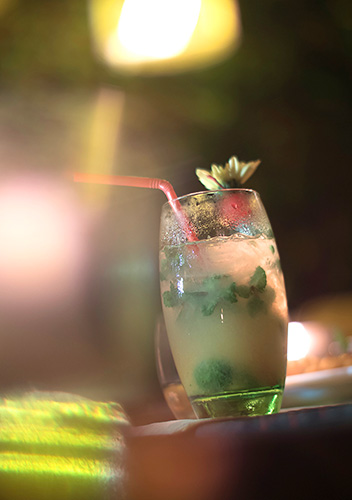Bokeh Glass Technique
Bokeh or Boke is Japanese for “the aesthetic quality of the blur produced in the out-of-focus parts of an image produced by a lens.” [source Wikipedia].
Different lenses have different characteristics and therefore different Bokeh effect.
Over time it’s come to mean an area of softness, which enhances another area of an image. So how about a cool technique that won’t cost you a penny. All you need are a couple of wine glasses and maybe a helper.
I learnt this Bokeh wine glass technique from my buddy Simon Taplin whom I run photo workshops with in Asia.
We were in a dark, confined courtyard in a restaurant in Vietnam with only one bulb on a wall for lighting and I thought how on earth will we pull a good one out of this.
But Simon’s many years experience as a top stock photographer for both Corbis and Getty Images left him completely unfazed.
“No problem.” He said. “We’ll just add a bit of Nonsense.” Which is what he calls this technique. With cameraman Jung one side and me the other holding wine glasses and only the bare bulb on the wall behind, Simon hand held his little Panasonic Gh4 and wowed us all.

Now don’t rush out to buy a Panasonic GH4 thinking you’ll take pictures like Simon does. It’s just a camera like any other.
My point is many of us worry way too much about kit, settings and gadgets when it’s much more important to develop our creativity. By that I don’t just mean composition.
I mean looking around, thinking of ways to use surroundings creatively, where to stand, what tools do we have at our disposal. In this case simple wine glasses made all the difference.
I so wish we had a shot of us all standing around as he did it so you could truly see how photo adverse it was.
Bokeh, spectral highlights or blur are only another level of creative thinking which has to be practised in order to grow. But how do you do it?
Slow down and stop snapping loads of frames hoping for a ‘good one’. It’s extremely unlikely there will be.
Look deeply at whatever’s captured your interest, imagination or (like Simon and I) what you’ve been asked to photograph. Look at it from different angles, from further away, from closer up. Look at what’s in front, behind and to the sides in each case.
Ask yourself powerful questions.
How does it look from here compared to here? What’s in the background or around it in each case? Do these things compliment or subtract from the subject? How can I deal with them? Would a longer or shorter focal length help? A blurry Bokeh background or sharp one? How can I hide the messy stuff to the side? Would a wineglass help?.....
These are a fundamental part of thinking like a photographer instead of someone with a camera. You are responsible for how your photos turn out, not your camera.
How did the great photographers of the past ever manage?
Henri Cartier-Bresson, Julia Margaret Cameron and Ansel Adams didn’t have 1000 point intelligent autofocus, multi point metering and a million menu options. And up until recently Sabastiao Slagado, Steve McCurry and a host of others didn’t either.
They had a shut, aperture, various speed films and maybe a split prism focus guide if they were lucky. Didn’t stop them did it? Of course there’s a lot of technology in a digital camera that’s really useful, but there’s also a lot more that’s a load of “Guff” in my opinion.
If you’re going to invest, invest in training yourself to use what you’ve got. It’ll be cheaper and far more rewarding both personally and photographically.
Take some wine glasses out with you and try some side Bokeh with landscapes, trees, trains, people, bicycles, portraits, ice, snow, mountains, steam engines and see what happens…

















































